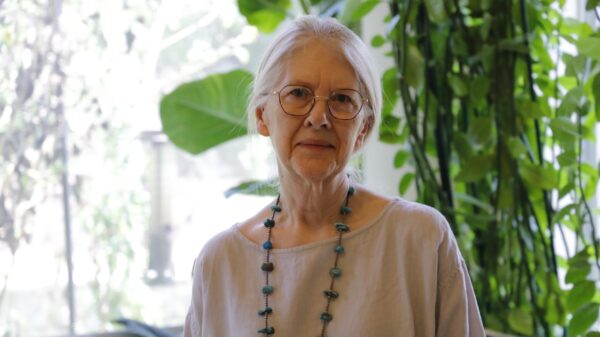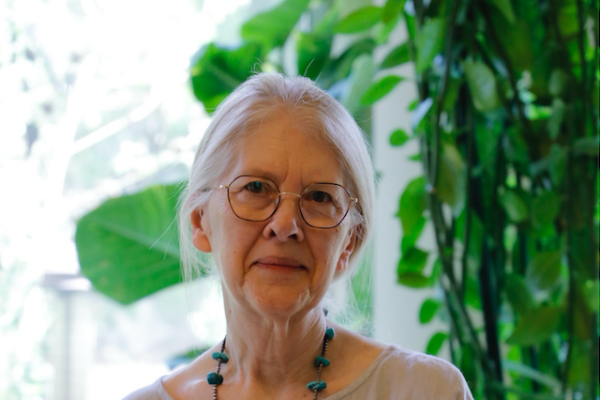by Michael Agresta
Growing up in San Antonio, Mary Braunagel-Brown, B.A. ’68, Ph.D. ’83, had only a distant sense of herself as belonging to the Osage Nation and the broader Native American community in the United States. Sure, her family often made the long trek up I-35 to Oklahoma to visit her grandparents on the reservation where her mother grew up, but it seemed part and parcel of an all-American childhood.
“My grandmother fed us too much food, we went to the local church on Sunday, and then we drove the 12 hours back to San Antonio,” Mary remembers. “It was just visiting your grandparents. Being Osage was something we knew about, but not until my mom and I got older was it something I found I should pay more attention to.”
As an adult, Mary’s identification with the Osage has deepened. “It’s an important part of who I am,” she says. In part to honor that heritage, she recently provided the first-ever endowment gift for the Program in Native American and Indigenous Studies (NAIS) at UT, a general fund she expects will support students in Native American and Indigenous Studies adjusting to life on campus, provide travel funds for NAIS-affiliated faculty at UT and bring occasional visiting scholars to campus.
Mary spent most of her adult life in upstate New York, where she worked for 20 years for the State University of New York system, and later in Austin, where she and her husband, Bruce Brown, retired in 2003. Although she kept up with news and current events from the Osage reservation, sharing her heritage with others was challenging; most Americans were unfamiliar with the Osage or their history. Then “Killers of the Flower Moon” happened.
The experience of Native people at UT Austin wasn’t anything that was acknowledged when I was an undergraduate or even a graduate student.
Mary is ambivalent about the 2023 Martin Scorsese film, which depicts a tragic period in the history of her mother’s tribe. She says she liked lead actress Lily Gladstone’s performance, had trouble sitting through three hours of Leonardo DiCaprio’s hick accent, and overall preferred the book of the same title from which the film script was adapted. Her favorite part of the movie was seeing familiar faces, including an Osage tribal council member, on screen.
“It was nice for a very small tribe — I think there are about only 20,000 Osages on the rolls now. They were getting a lot of publicity and got tourists coming in,” she says. “It’s giving them an income stream up in a small town in Oklahoma. It was nice, but, you know, let’s get back to reality.”
For Mary, that means getting better leadership for the tribe in the here-and-now (she is excited that the current Osage chief has a background in Indian law) and improved economic opportunities on the reservation. It means attending to the reality of Native erasure on campus on the UT campus. “The experience of Native people at UT Austin wasn’t anything that was acknowledged when I was an undergraduate or even a graduate student,” she says. “It wasn’t there.” It wasn’t until 2006, in fact, that Native American and Indigenous Studies was established as a program, being previously only a faculty “initiative.”
Mary says she has no personal horror stories of feeling lost or in need of mentorship when she was an undergraduate in the 1960s, but she was coming from a background as a big-city high school valedictorian and Phi Beta Kappa. “School was what I could do,” she says. She recognizes that not all young people arrive at UT with the same level of confidence and ability to navigate on their own. Via NAIS, she recently heard from one such undergraduate, a young Native man from out of state. “He grew up in an area where there were a lot of people in his tribe, and he was talking about how important it was for him to have a place to feel like he belonged,” Mary says, adding that NAIS offers that sort of community as part of its mission.
In recent years, thanks to the Mary Braunagel-Brown Excellence Fund for Native American and Indigenous Studies, the NAIS Program has supported UT students’ internship at Great Promise for American Indians, allowing them to participate in the organization of the Austin Powwow. In the fall of 2023, NAIS launched the Braunagel-Brown Endowed Lecture in Native American and Indigenous Studies, which aims to sponsor an annual lecture by a leading scholar in the field of Native American studies.
“This is an extremely important support for the intellectual, cultural and educational work of NAIS students at UT Austin,” says Luis Cárcamo-Huechante, associate professor of Spanish and Portuguese and former director of NAIS, “as well as for our continous endeavor to connect and collaborate with the broader Native American community here in central Texas.”

Mary is well-acquainted with the model of providing support to UT students from atypical backgrounds. Her first gift to the University, given in 2013, supports the INSPIRE Leadership program at the Center for Women and Gender Studies (CWGS), a three-year revolving program that helps students develop the skills they need to achieve the highest levels within their chosen academic fields. She felt drawn to that program in part because she was the first woman to attend college on either side of her family.
“INSPIRE gives them mentors for three years — somebody they can go to and figure out this 50,000-person place,” she says, noting that some INSPIRE students come from small towns of 10,000 people or less. “It helps them navigate and gives them a shoulder to cry on when they feel lost. That really spoke to me.”
Mary sees both her gifts as a tribute to her fond memories of UT. It’s where she met her husband and where she felt so at home academically that she returned for an M.A., then for a Ph.D., and finally, in 2003, to be part of the local alumni community. But it’s also a tribute to the source of some of her ability to give — the Osage oil rights that go back to the “Killers of the Flower Moon” era.
“I’m delighted to use the money I receive as an Osage shareholder to support CWGS, and now, even more so, to support NAIS, because it’s working with Indigenous people,” she says.
Above all, Mary looks at her gift as a seed for future growth, especially for the NAIS program, which is still a fledgling presence on campus — a small entity with the mighty task of addressing 500 years of omissions and disadvantages in the United States. She was motivated to give to INSPIRE in 2013 because she saw the positive impact of an earlier 2009 gift to CWGS made in honor of UT women’s basketball coach Judy Conradt. She hopes her NAIS gift will likewise serve as a model.
“$100,000 is a significant amount of money, but it’s not going to change the studies program overnight,” she says. “But it does give them some credibility to then go to other donors and say, ‘Well, we’ve had this Mary Braunagel-Brown Excellence Fund donation, and we’ve used it for this, and if you would invest in us, we will do more.’”




